DJI
DJI Mavic Mini: the essence of Mavic in a 249 g drone that fits in your hand
Aprox. 499€ - see price -
See specificationsAfter having conquered the amateurs of shots with its foldable quadavotors Mavic, DJI puts back the cover with an even more compact and light drone, to take everywhere with you: the Mavic Mini. The real replacement for Spark?
Positive points
Compact and light.
Easy to use.
Good autonomy.
Charge in micro-USB directly from the drone.
Quieter than the other Mavics.
Real radio control supplied.
Bad points
Definition limited to 2.7K at 30 fps.
No obstacle detection.
No detection or tracking of people and vehicles.
Connection and charge in micro-USB and not USB-C.
No charge directly on the battery.
One-piece propeller guards, not very transportable.
Photo only in Jpeg, not Raw.
Only 4 automatic modes, lack panoramas, timelapses, 360 ° ...
Our review
Presentation
Thanks to their foldable design, Mavic drones have managed to reach the backpacks of many amateurs and even image professionals who no longer hesitate to take their drone with them everywhere. The general public and the most nomadic have for their part gladly turned to the Spark and the Mavic Air, significantly more compact than the "Pro" models (Mavic Pro then Mavic 2 Pro and Mavic 2 Zoom). Helping miniaturization, there was still room to do even better, and DJI shows it with a new Mavic even more compact: the Mavic Mini, a quadrotor taking the foldable design of its elders, but weighing this time less than 250 g and with the best autonomy for the family (30 minutes announced).
Clearly intended for the general public and positioned at the entry level with a starting price of € 399 (€ 499 in Fly More Combo pack including a case containing 2 additional batteries and a 3-battery charger, as well as propeller protections), it comes with a new simplified smartphone application, but keeps the essence of Mavic with its stabilized camera, its low latency radio transmission, its different viewing modes and its simplicity of piloting. A little gem on paper, therefore, despite some limitations related to its compactness and in order to preserve the rest of the range of DJI drones, which we will of course discuss in more detail in this test.
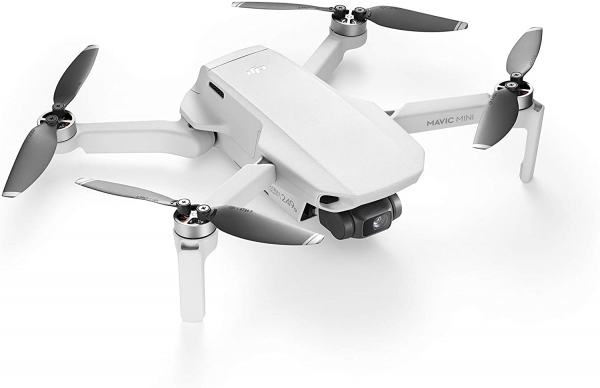
Getting started
Significantly more compact than the Mavic Air - which already made the Mavic Pro look like a juggernaut - the Mavic Mini really fits in the palm of your hand, since its dimensions are reduced to 13.5 cm in length by 8.5 cm wide and 5.5 cm high.
A great feat since it thus becomes less bulky than that which until then occupied the place of the manufacturer's smallest drone, the Spark. The secret? Its foldable arms, of course, the most striking feature of the Mavic series drones, significantly reducing the size of the device for transport.
Once unfolded, the Mavic Mini shows a larger wingspan than the Spark (14.3 cm side), since it then measures in width (without taking propellers into account) 20 cm at the front and 18.5 cm at the back, for a total length of 16 cm. What gain a little stability and especially away from the propellers of the camera field. It remains nevertheless more compact than a Parrot Anafi.
Small size and lightness oblige, the Mavic Mini takes on the air of a miniature drone, and one could even believe in a toy at first glance, like the innumerable low-cost devices such as the Eachine E58, for example. The comparison ends happily there, the Mini being the rest, like its big brothers, a real flying camera and not a gadget intended simply for fun. Admittedly, its manufacturing quality still drops a notch compared to other Mavic and even Spark, evidenced by the thin and flexible plastic now used, but the finishes are still very correct.
We feel that DJI has made efforts to preserve a certain seriousness of construction despite the objective which was to go below the 250 g mark. A limit not to be exceeded for a drone in certain countries like the United States if one wishes to dispense with a declaration (to the FAA concerning the United States). In Europe, however, this limit is likely not to change much, the future regulations providing from June 2020 a compulsory registration of any drone "which is not a toy and equipped with a sensor able to capture data personal". In any case, we encourage you to follow the free online training on the AlphaTango site, leading to the issuance of a certificate (also authorizing the piloting of drones over 800 g), but above all allowing you to learn the flight rules and regulations in place that will affect this Mavic Mini just as much.
That being said, let's finish this overview of the Mini which still shows several differences compared to other Mavic. First of which is the location of the battery. This now fits into the device under a hood on the back, unlike previous DJI quadri-rotors on which the battery completed the body of the device and remained visible. The Mavic Mini's battery installation and removal is simple, and it seems unlikely that it will come off after a crash. On the other hand, we doubt a little more the robustness of the hatch, in particular its plastic studs which keep it closed, but it is difficult to truly judge its resistance in a week of use.
On the back of the device, there is also a microSD memory card slot which is not protected by the battery slot cover, but precisely avoids having to open and close it even more frequently. In fact, if you only use one battery, it will remain in the drone since it will only be recharged by the micro-USB socket located next to the microSD slot, due to the lack of a dedicated charger in the basic pack or charging socket on the battery itself.
As general public as it is, the Mavic Mini is supplied with a real radio control, with a design also very similar to that of other radio controls for Mavic. However, the control screen and several buttons are lost. The finishes are also slightly below, but it is already amply satisfactory and we find with pleasure the compactness proper to these models as well as the handles of removable analog sticks. We always appreciate the position of the smartphone on the bottom, which avoids an imbalance towards the front.
As with other Mavics, this radio remote control works in conjunction with a smartphone on which an application has been previously installed. DJI GO 4 point however, this is a light version, called "DJI Fly" and offering a more refined interface, with only the essential information on the screen (flight height and distance of the drone compared to the radio control, map of the area with GPS location, radar indicating which direction the drone is in, remaining range (in minutes), battery level and signal strength, as well as photo and video adjustment and trigger commands.
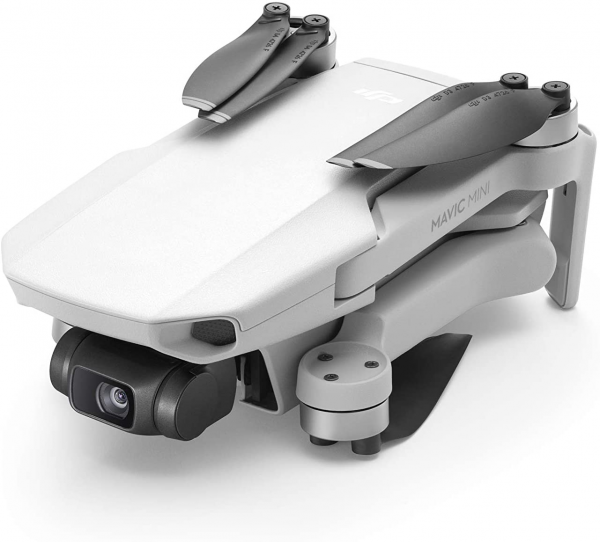
Flight
Controllable only with the supplied remote control, the Mavic Mini is even easier to use than its big brothers. Take-off: is done by a simple press on the virtual button of the touch interface or manually by orienting the sticks down and the center of the radio control. In automatic mode, the drone takes off and stabilizes at approximately 1.50 m above its starting point. The device's unique sensors, located on the bottom, then serve to keep it in a horizontal and vertical position, with a certain efficiency, even in windy conditions. It is also quieter than other Mavic, approaching in this way the Anafi.
If it is fatally less fast than the Mavic Pro and Mavic 2 of this world, the Mavic Mini can nevertheless count on good engine power, allowing it to quickly gain height, to resist winds up to 28 km / h and fly up to a speed of 29 km / h in Position mode and even 47 km / h in Sport mode. Make no mistake, it is still moving much more slowly than its big brothers (72 km / h for the Mavic 2, 68 km / h for the Mavic Air), the filmed sequences will be more laid. The range is anyway less than that of Mavic 2 and we will not therefore have to venture too far at high speed to reach a place to film in particular. DJI still announces a distance of up to 2 km. During our tests, we were able to fly quite easily up to 1.5 km when there were not too many obstacles between the radio control and the drone. In wooded areas, however, we lose the signal well before (500 m during our tests on the banks of the Loire), but this is the case with any drone. Results equivalent to those obtained with the Mavic Air, finally. The video return signal is done in 720p on the smartphone. It is fairly stable and recovers well when the drone returns to range.
Good news, in case of loss of signal, the Mavic Mini automatically triggers a return to its take-off point (RTH function, for "return to home" in English), flying at the height indicated in the application (30 m by default ). However, care should be taken not to venture behind or under obstacles that the drone could hit on its way back, since it has no obstacle sensors and therefore somehow flies blind when it automatically returns to the fold. A loss undoubtedly inevitable to obtain a device as light as possible, but which does not prove really troublesome in practice, insofar as it is necessary anyway to remain careful when piloting a drone and in principle to keep it in direct view to comply with French legislation (forget the idea of flying 1 or 2 km, therefore ...).
This loss of obstacle sensor on the other hand has a slightly more unfortunate impact: the Mavic Mini does not offer the famous Follow Me function of its elders which allows you to follow a moving subject. No doubt to limit the risk of accident during careless use. However, this would have been possible, with for example an on-screen display of precautions to be taken (no obstacles between the subject and the drone), Parrot indeed offering such a function on its Anafi. Likewise, DJI has also put an end to Active Track, the image recognition technology that allows other Mavics to keep the camera focused on its subject at all times. The shooting capacities suffer the consequences.
However, this recognition of subjects does exist on the Mavic Mini, through the famous QuickShots modes used to take automated shots. The Mavic Mini therefore has Dronie, Rocket, Circle and Spiral modes. We would have appreciated taking advantage of other functions to realize in particular panoramas, timelapses, etc.
Selfie and group photo enthusiasts will be delighted to learn that the Mavic Mini is also designed for indoor flying. In its Fly More Combo version, it has large protections that attach firmly to the engine arm, which completely include the propellers. Also useful for starting piloting, since the drone is protected from all sides, even on top (on the bottom, it can count on its sensors).
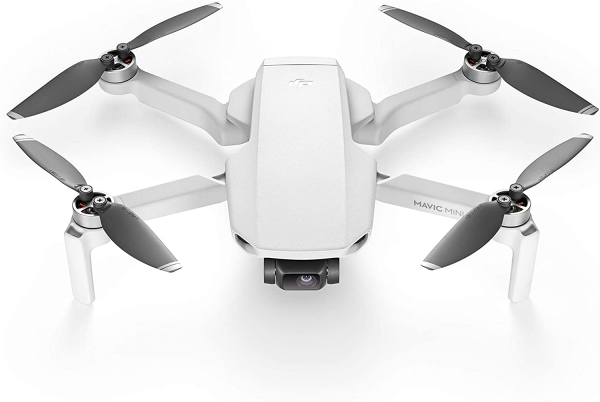
Image quality
With its 12 MP 1 / 2.3 "CMOS sensor (same characteristics as those of other Mavic, except Mavic 2 Pro), the Mavic Mini is capable of filming up to 2.7K (2,720 x 1,536 px) 30p at an angle of 83 ° ( focal length of 24 mm f / 2.8 in 35 mm equivalent). Ultra HD 4K definition point, alas, which remains the prerogative of Mavic Air, Mavic Pro and Mavic 2. It is regrettable, especially since DJI has shown with its Osmo Pocket that It is possible to do it with very small cameras. According to DJI, this absence is explained by the search for maximum compactness. We can also assume that this limitation reduces costs by using less efficient components, while preserving the autonomy of the Mavic Mini. From the consumer's point of view, however, it still looks much more like a simple segmentation of the range so as not to overdo it. Shadow at Mavic Air. We could at least have hoped for a recording rate of 60 i / s in 2.7 K, but this rate does not is only available in Full HD definition.
In the state, it is still much better than the Full HD 30p of Spark and there is a good bet that a good number of users will content themselves cheerfully, especially since it is much more simple to find a computer capable of editing videos in Full HD, even 2.7K, than a computer capable of supporting heavy 4K files (the Core i7-2700K of 2011 attests to this…).
The image quality is in any case satisfactory, although inferior to that offered by a Mavic Pro or a Mavic 2 Zoom. The sharpness is quite good in the center of the image, but degrades on the sides. We also observe some optical deformations in the angles on our test pattern, but nothing that is not very visible in practice. The color rendering is also quite flattering, the colors being more vivid compared to what we get on the Mavic Pro and Mavic 2.
Finally, apart from the loss of Ultra HD 4K definition in video, the video results are quite close to those obtained with a Mavic Air. In photo, however, the latter remains a little better and produces files in RAW format which give more control over retouching, which the Mavic Mini does not do.
Although the Mavic Mini does not display as large photo and video claims as its big brothers Mavic Air and Mavic 2, it does ...
As for the settings, there is an exposure correction in automatic mode and a selection of the sensitivity (100 to 3,200 ISO) and the exposure time in manual mode (in photo as in video).
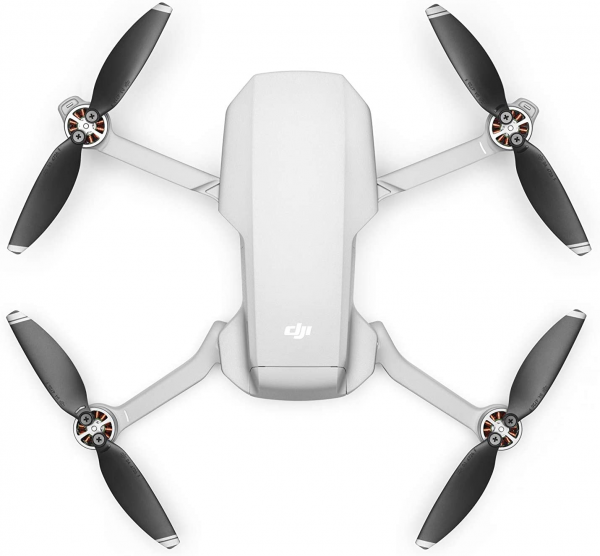
Autonomy
DJI promises up to 30 minutes of flight time for its Mavic Mini with the 2400 mAh Li-Ion 2S battery. In practice, we actually approach it under ideal conditions (without wind and at a constant speed of 14 km / h, according to DJI) if we disregard the first critical battery alerts. In normal use, however, a return to take-off point is initiated when the battery capacity drops to 20%. We then flew about 25 minutes, which is already comfortable and enough to make beautiful sequences. By canceling the automatic landing commands, you can gain approximately 2 minutes of flight time. The 30 minutes are finally reached only by forcing the drone to stay in the air, using the left stick of the radio control. To be reserved for emergency situations therefore. With its propeller protection which adds 50 g, the Mavic Mini necessarily flies shorter: 18 minutes maximum according to our tests.
If you want to film longer, the purchase of the Fly More Combo pack is recommended, since it allows you to take advantage of two additional batteries and a 3-battery charger. Since you cannot directly charge the battery, unlike that of an Anafi which has a USB-C port, the external charger quickly becomes essential if you want to be able to charge your other batteries while the Mavic Mini is in flight. However, it takes approximately 1 hour 15 minutes for a battery to recharge (consumption: 0.02 kWh). We can therefore hope to use the other two batteries in the meantime, and finally take advantage of four full charges during the same outing (ie about 1 h 40 min flight). Too bad the charger only charges one battery at a time and especially does not charge faster.
Note that the 3-battery charger can also be used as an external battery, to recharge your smartphone or radio remote control, for example. Convenient in mobile use.

Conclusion
The smallest drone of the Mavic family has no shortage of assets to seduce the general public who will ignore its few shortcomings, first of which the Ultra HD 4K definition and the monitoring of subjects. It is thus more like a replacement for the Spark than for the Mavic Air, being just as easy to fly with its radio control. Obviously, we lose the obstacle sensors and gesture controls, but we gain an even easier device to take with us, which we will no longer hesitate to slip into a bag before leaving for a walk, as we would do it with a small camera.
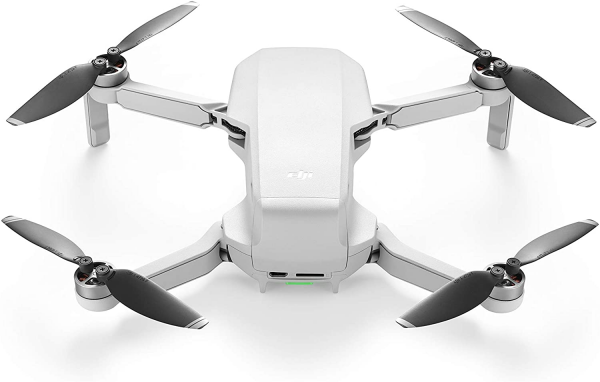
Specifications
Reviews

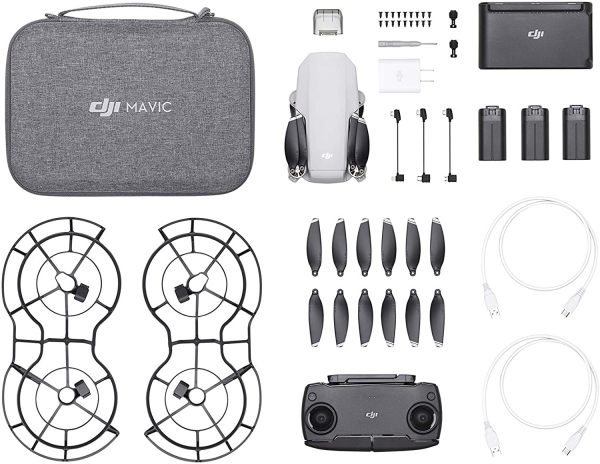
Blown away how cheap and good this drone is.
I built a quad several years ago. It was very difficult to fly and had no camera, gimbal, etc ... I've heard a lot about DJI over the years, so I decided to try the Mavic Mini with the $ 400 price (this was double what the parts cost me for my first drone!) My phone didn't support the DJI Play app, so after BUYING A NEWER PHONE I was able to fly the Mavic Mini. I am blown away! Stable, smooth, I am VERY happy with my purchase. Video is clear, sharp, and excellent frame rate. More than enough for personal use, or even YouTube videos.